Story of Patty Mills: Spur, Aussie, Bala

This story appears in the March 23, 2015 edition of SI. To subscribe, click here.
The Spurs would soon turn their attention to the Heat, their opponent in the NBA Finals, which were set to begin two days later. They would go over the importance of clogging the middle against LeBron James, of scrambling over the tops of screens set for Ray Allen, of keeping Chris Bosh from facing up on the block. But last June 3, as the Spurs gathered in the video room at their practice facility, an entirely different item topped coach Gregg Popovich’s agenda.
“Anybody know what today is?” Popovich asked.
Patty Mills knew, but the Australian point guard couldn’t bring himself to speak—not after the portrait of a black man in his 40s, with a beard and freckles, flashed up on the screen. The intimacy of the photograph, Mills’s familiarity with the man and his story, and the unexpectedness of what was unfolding before him combined to “make my hair stand on end,” Mills says. “It wasn’t just any practice or meeting. It was to prepare for the NBA Finals and the Miami Heat. We’re all geared up, and that’s the first thing he says.”
It was left to a fellow Aussie, center Aron Baynes, to answer, “It’s Mabo Day.” And with that, Popovich launched into the story of Australia’s Martin Luther King Jr.
Eddie Koiki Mabo grew up in the Torres Strait, which separates Australia’s Cape York Peninsula from Papua New Guinea. Well into the 20th century, inhabitants of the strait’s scatter of islands, which are considered Australian territory, had to endure the indignities of segregation, government control over their movements, and wages paid in credit rather than cash for food and housing. When Mabo learned that Australian law didn’t recognize his right to inherit land that had been passed down through generations of his family, he became the lead plaintiff in a legal challenge to the doctrine of Terra nullius, which held that Australia had been unoccupied before white Europeans began to settle the continent in 1788. The case took a decade to wend its way through the legal system. But on June 3, 1992, five months after Mabo died at 55 in the arms of his wife, Bonita, and exactly 22 years before the Spurs met in that video room, the High Court of Australia ruled 6 to 1 in Mabo’s favor, enshrining the concept of “native title” in Australian law. The preexisting legal regime, one justice wrote, “made the indigenous inhabitants intruders in their own homes.”
Mills pulled himself together enough to add a few comments about the Mabo decision at Popovich’s invitation. “You could see that he was pretty moved by it all,” the coach says.
On a team with more international players than domestic ones, Mills’s background is easily the most exotic, for he carries the blood of both of Australia’s indigenous peoples. His father, Benny Mills, grew up in the Torres Strait, where for centuries people of Melanesian descent, who made a living fishing, gardening and diving for pearl shell, intermixed with the Japanese, Filipinos, Indonesians, Malays and South Sea Islanders who plied the region’s trade routes. Patty’s mother, Yvonne, is the product of a liaison between a white man and an Aboriginal woman. She belongs to Australia’s so-called Stolen Generations: tens of thousands of mixed-race children, known pejoratively as “half-castes,” who were taken from their mothers and placed in group homes and missions from the late 1800s to the 1970s in a social engineering project sanctioned by both the Australian government and various churches. Although some of the children were rescued from abusive circumstances and placed in foster care with white families, historians say the project was part of an effort to “smooth the pillow of a dying race,” as the early 20th century Irish-Australian welfare worker Daisy Bates described it—to socialize the children as white in hopes of breeding their indigenousness away.
As pep talks go, Popovich’s Mabo Day remarks were a tour de force. The coach often devotes a portion of team meetings to the culture or history of some member of the NBA’s most nationally diverse outfit. “Nine of our 15 are from elsewhere, and I’m always looking for ways to make them part of the story,” Popovich says. And while he is reluctant to draw a straight line from the Spurs’ recognition of Mabo Day to the star turn Mills would take in those Finals, he believes that knowing one another’s stories off the court binds the Spurs on the court. “It builds camaraderie and helps them grow as people, and all that carries over,” Popovich says. “They feel connected and engaged and do better work.”
The overflowing legacy of Steve Nash
Carrying the mantle of Mabo over the ensuing fortnight, Mills made a name for himself. As a substitute for starter Tony Parker, he grabbed the decisive Game 5 by the scruff in the third quarter, scoring 14 points in five minutes on four three-pointers and a reverse layup past James. As San Antonio made short work of Miami, ABC’s Jeff Van Gundy and Mark Jackson needed something else to talk about, and when they spoke on air of Eddie Mabo and the Torres Strait, it all seemed to be part of Mills’s master plan to use his gift for the game to spread the culture and tradition of his people. “You represent your family, mum and dad, your school and your culture,” he told an auditorium of boys in blue blazers last September during a visit to Marist, the Canberra day school he attended for five years. “Now that I get a chance on the big stage, it’s even more important to remember where I came from.”
The ancestry that makes the 26-year-old Mills a role model for First Australians helped turn him into a basketball player. As adults, his parents separately found their way to Canberra, the capital, to work in indigenous affairs for the federal government. There they met and married, and together they founded and ran a basketball club for indigenous boys and girls, the Shadows, for which their only child began to play at age four. In the moments after the Spurs won the 2014 title, Benny Mills handed his son two flags, which Patty’s girlfriend, Alyssa Levesque, had borrowed from an Aussie pub in San Antonio. Patty passed one, the familiar Southern Cross of Australia, to Baynes. Around his own shoulders he draped the Torres Strait Islander flag, with its bars of green (for the islands) and blue (for the sea), its white five-pointed star (for the five island clusters and the islanders’ tradition of celestial navigation) and its white dhari, or traditional headdress of crane feathers (for the people).
[pagebreak]
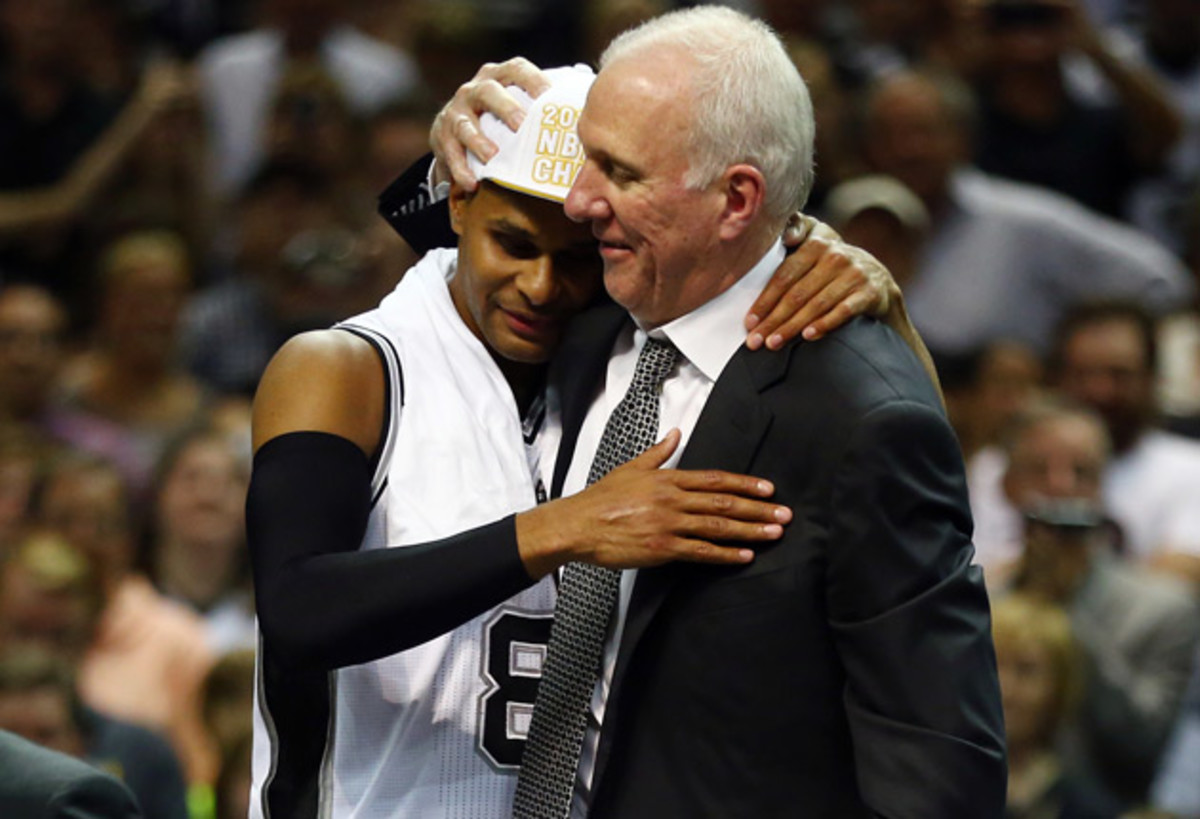
The walls of the locker room in the Spurs’ arena, the AT&T Center, are festooned with the same Popovich-chosen motivational saying, posted in every language represented on the roster, including Meriam Mir, which is spoken in the eastern Torres Strait. “I wasn’t interested in ‘There is no I in team’ or any of that crap,” the coach says. Instead the words are from Jacob Riis, the 19th-century Danish immigrant to the U.S. who became a social reformer and championed the stranger in a strange land: When nothing seems to help, I go back and look at a stonecutter hammering away at his rock perhaps a hundred times without as much as a crack showing in it. Yet at the hundred and first blow it will split in two, and I know it was not that blow that did it—but all that had gone before. Ordinarily the Spurs outsource the Riis translations to linguists at San Antonio’s Trinity University, but Meriam Mir is so obscure that Mills’s relatives had to be enlisted to help.
Indigenous Australians have a hard-won understanding of the sentiment at the heart of that quote. But there’s a saying in the Torres Strait that echoes the words of Riis. It speaks both to the Spurs’ philosophy as an organization and to the mentality that Mills has taken with him to the NBA: Your past must connect with your present to create your future.
Eddie Mabo was Patty Mills’s great-uncle—Benny Mills’s uncle on his mother’s side. Elders on Murray Island disapproved of a romance Eddie had as a 16-year-old and, in 1952, exiled him to the mainland, where he worked the wharves, railroads and cane fields of Queensland. In the port city of Townsville, he founded the Black Community School to pass along the music, dance and folkways of the Torres Strait to children of islander descent. Then, as a gardener at James Cook University in the ’70s, he befriended two professors who mentioned over lunch one day that the state considered his father’s plot back on Murray Island to be “Crown land.”
Hearing this, Mabo vowed to learn all he could about relevant Australian law. At a land rights conference in Townsville in August 1981, attorneys and activists joined Mabo to plan a test case. Benny Mills, who had been sent to the mainland himself following 10th grade after exhausting the schooling available on the islands, sat in the room that day. “We’re all like, Go for it,” he recalls. “We all know it’s your land, even if the state denies it.”
• MORE WOLFF: From SI writer to ABA owner: Vermont Frost Heaves
To help make its case, Mabo’s legal team introduced testimony about Malo’s Law, the code by which people in the eastern Torres Strait had abided for centuries: The god Malo came to Murray Island in the form of an octopus. With his tentacles he induced the island’s eight clans to work together and, as one tenet of Malo’s Law enjoined them, tag mauki mauki, teter mauki mauki, roughly “keep your hands and feet off the land of others.” Patty wears number 8 because it was the number of his uncle Sam Mills, the first person to leave the Torres Strait to train as a basketball player at the Australian Institute of Sport in Canberra. But it is also the number of an octopus’s tentacles. “Maybe,” Patty says of his uncle, “he chose it for that reason.”
Even before she met Benny Mills, Yvonne Haynes knew his uncle Eddie. She and he had worked together on a national committee on indigenous education. Her own commitment to the cause of First Australians had grown out of a family story that evokes the 2002 film about the Stolen Generations, Rabbit-Proof Fence.
Yvonne was born in South Australia to Gladys Haynes, a member of the Ynunga Aboriginal tribe who had grown up at Koonibba Mission, a Lutheran children’s home for Aboriginal children. There Gladys was taught to cook, clean and sew, and at 12 she was sent to work as a domestic with a white family. Authorities gave her an “exemption certificate”; without it, she would have been prohibited by the Aboriginal Protection Act from living among white people. But it was a devil’s bargain, for the certificate came on the condition that she forswear her heritage and not associate with other Aborigines. “Because my mother had the certificate, by law she was white,” says Yvonne Mills. “But she looked Aboriginal, so she was treated that way.” The certificate, which many Aborigines derisively called a “dog tag,” also made her ineligible for support from the Aboriginal Protection Board, which might have helped her find housing. When welfare officials took her children away, they cited her inability to house them to the state’s satisfaction.
A Giant Shadow: Did Wilt Chamberlain have a son? Levi may be living proof
Yvonne can’t recall being separated from her mother because she was barely two when it happened. But older siblings have recounted that day in 1949: five of them locked in a room, from which they were taken one-by-one to be placed in group homes. For years afterward, if they asked after their mother, they were told that she didn’t want them. Only in the late ’90s, thanks to a government inquiry into the separation of Aboriginal children, did Yvonne and her siblings find Gladys Haynes’s entreaties to the authorities: letters reading, Please give me my children back and A promise is a promise. “We knew what had happened to us, but reading the records we learned what happened to her,” Yvonne says. “How she tried to get us back and they kept shifting the goalposts: ‘Get a house.’ ‘So many rooms.’ There was also mention of her color, ‘her dark appearance.’ You could read between the lines.”
Yvonne had supervised visits with Gladys, but she didn’t see her mother again in public until age 17, when welfare officials gave her permission to attend the wedding of her sister Beverley. By then Yvonne had been put in foster care with a white couple. Her foster father worked for the railroad, which transferred him often, and at each stop Yvonne encountered new schoolchildren to call her darky or n-----. Welfare officers who looked in on her administered regular humiliations, such as giving her an intelligence test because she was shy and quiet—only to conclude, when she proved to be perfectly smart, that she suffered from an inferiority complex. “It wasn’t only the stigma you’d get for having an Aboriginal background, but what you had to go through as a ward of the state,” Yvonne says. “People say, ‘Get over it.’ But there are still deep wounds.”
After completing her schooling, Yvonne tried to become a hairdresser, knocking on salon doors in Adelaide to no avail. But Beverley’s wedding had provided a breakthrough. “My sister and I had been brought up by different people, but the mannerisms, the way she talked—it was me,” Yvonne says. “I found my family and really began to find my identity.” Embracing her heritage, she took that posting to Canberra in indigenous affairs. Meanwhile, the results of the government inquiry affirmed her on another level: “My experience was true, because it happened to lots of others too.”
Last summer Patty visited his grandmother’s grave for the first time. Gladys Haynes, who died at age 60 in 1979, now rests a short drive from the Koonibba Mission where she spent her childhood. Because she was forcibly separated from her Aboriginal roots, her grandson will always be more conversant with the culture of his father’s people. “I grabbed my dad’s side by the horns,” he says. “I understand only parts of my mum’s culture, what with mum not being fluent in her own language because of what happened.”
[pagebreak]
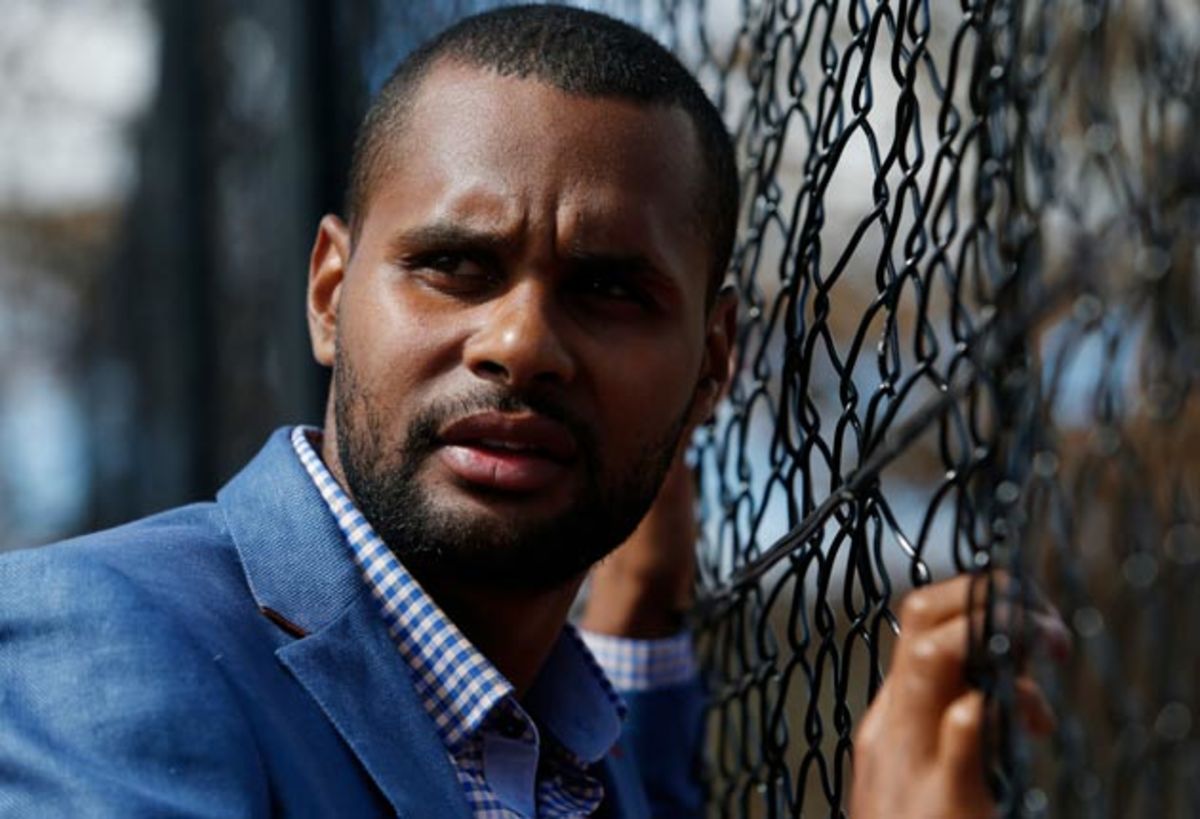
He’s nonetheless acutely aware of representing both categories of First Australians. For an American counterpart, you’d need to find the son of a father who marched in Selma and a mother whose Cherokee family walked the Trail of Tears. “He takes a lot of pride in being the first Indigenous Australian to win an NBA championship,” says Baynes. “But he’s just as proud if not more so to be able to do it for [all] indigenous people.”
The odds of becoming an NBA champion are long, almost impossibly so if you’re 6 feet tall with a grandfather who was a pearl diver in the Torres Strait and a grandmother who was raised in a mission home out in the bush. Yet when Patty was two, that grandfather, Sam Mills, put up a basketball hoop outside his home on Thursday Island so Patty could shoot hoops on visits to the Strait. Back in Canberra, where Yvonne and Benny found a place for their little boy with an indigenous dance troupe and tucked him into bed to tapes of island songs, the Shadows further forged his identity. Playing in tournaments around Australia, the team encountered the occasional racist taunt, but the Millses insulated Patty and his teammates from the worst of it. “My main focus was to empower them,” Benny says, “so that anything they’d face they could manage.”
James Harden, the NBA's unlikely MVP
After dalliances with rugby and Aussie Rules football, Patty settled on basketball, enrolling at the Australian Institute of Sport at 15. Three years later he became the youngest player ever to attend the training camp of the Boomers, Australia’s senior national men’s team, and the following fall he headed to Moraga, Calif., to play for St. Mary’s. It was there that Mills began to notice a pattern. “I appear African-American,” he says, “so it’s not until I start talking that people go, ‘Hold on, there’s something not right here.’ But it’s an awesome conversation starter. I open my mouth, they get curious, and I say, ‘Got a few minutes? Have a seat.’ There’s a part of me that’s very stereotypically Australian, with the lingo, or for lack of a better way of putting it, the way white Australians would speak. And then, Oh, that’s not all I am. . . .”
Last season Popovich pointedly asked Mills if he considered himself black. Mills and his girlfriend could only laugh later the same day when, filling out a form at the DMV, he had a chance to check a box marked black. He chose not to. “He knows who he is,” Levesque says. “He knows his heritage. It’s a matter of getting other people educated about it.”
After Mills’s second season in the Gaels’ backcourt, the Trail Blazers chose him with the 55th pick of the 2009 draft. In Portland he became the guy on the bench who would accessorize teammates’ three-pointers with a goofy gesture called “3 goggles.” But the lockout stunted his development with the Blazers, and in March 2012, shortly after the end of the work stoppage, he signed with the Spurs.
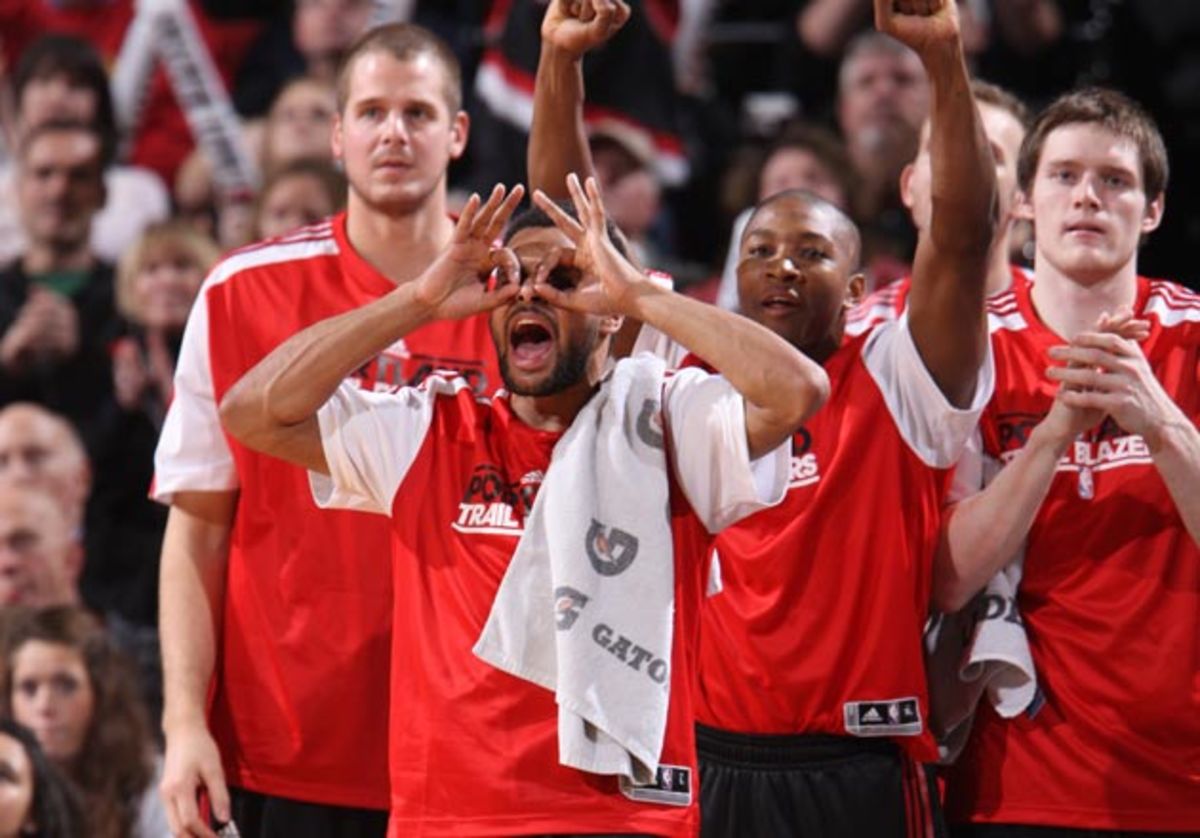
In San Antonio, Mills quickly won over teammates by turning towel waving into performance art and hooking up his guitar to the P.A. system on the team charter to serenade them with songs such as Sam Cooke’s “Cupid.” But he wasn’t really contributing on the floor. “In the playoffs you have to trust a guy completely,” says Popovich, who used Mills for only 14 minutes during the 2013 Finals. “That first year he was a little bit of a wild card. He’d make turnovers at critical times. We needed to inject him with a little more point guard savvy rather than that two guard ‘I’m gonna let it fly’ mentality.”
Mills sat down at the end of the season and, he says, “had a good think.” He made himself over physically, adopting a variation on the paleo diet and halving his body fat to below 7%. “He’d been a little bit of a chub,” says Popovich, who noticed that the extra pounds impaired Mills’s ability to defend. “As soon as he came to camp we noticed he was quicker, faster.”
The payoff was immediate. According to numbers run by SportVU, Mills covered more distance per 48 minutes last season than any other player in the league. His newfound fitness showed particularly in the effectiveness of his pull-up jumper in transition. The PUJIT is among the most difficult shots to sink consistently, yet when it drops, it can be a tire iron upside an opponent’s head. A year ago Mills made 48% of his PUJITs, a rate far greater than that of anyone else in the league who launched them as often. Given Mills’s fitness and court coverage, no one begrudges him his PUJITs. “You earn the right to take those,” says teammate Boris Diaw, a forward from France, “if you’re impeccable on D.”
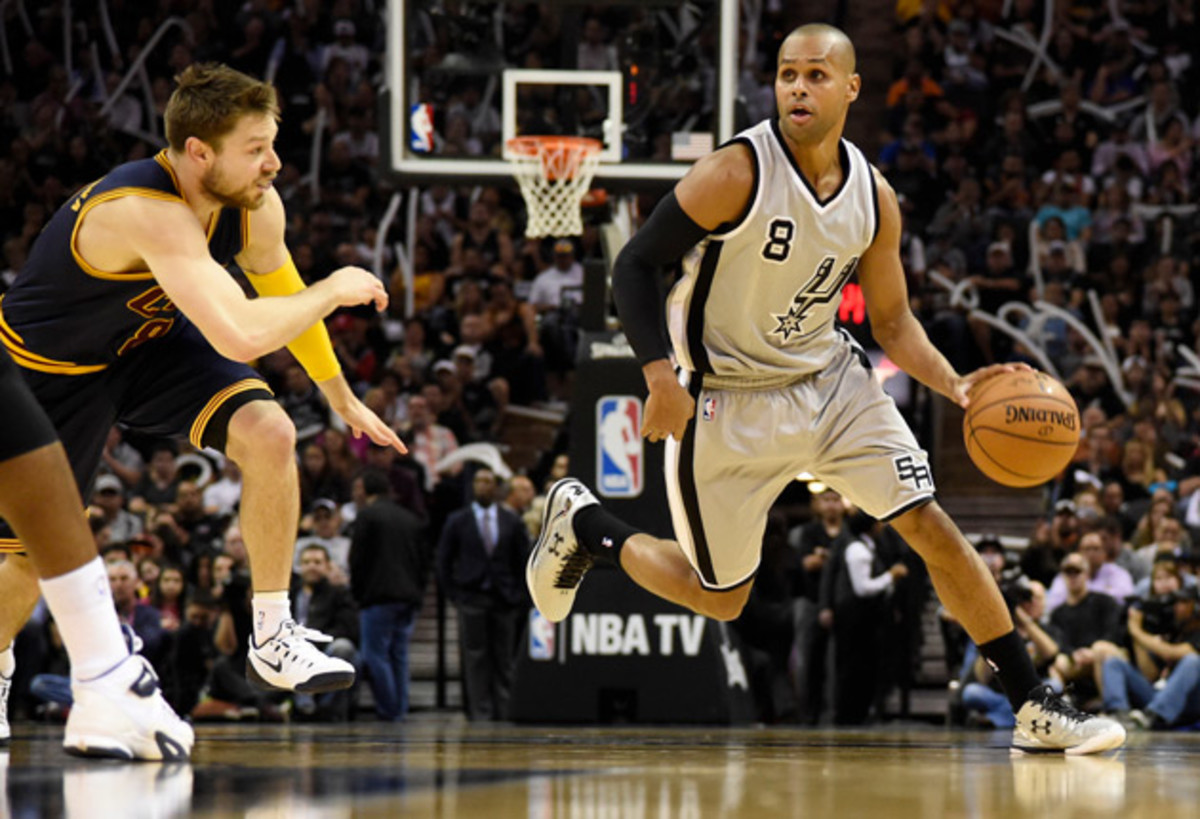
With last June’s title, Mills went from the guy waving a towel to the one waving a flag. Over the summer the Spurs re‑signed him for three years even though he had been diagnosed with a torn rotator cuff during his exit physical. It turned out he had been laying out for all those loose balls with a bum right shoulder.
The Spurs knew he would miss the first two months of this season recovering from surgery, but of the decision to commit $12 million to keep an injured free agent, Popovich says, “It wasn’t even a question. Obviously he can shoot the basketball and has a lot of energy. But he’s beloved on this team for his enthusiasm, his kindness, his understated gravitas. As long as I’m here, he’s going to be here. Unless we can’t afford him.”
With additional injuries this season to Parker, Finals MVP Kawhi Leonard and Brazilian center Tiago Splitter, all starters, the defending champions are only just rounding into form, having won seven of their previous eight games through Sunday. “I want the ball to move like it did last year in the playoffs, and I haven’t seen that yet,” Popovich says. “We’ve had guys who’ve been out coming back, pressing a little bit and wanting it too much, instead of trusting each other and the system.”
The coach’s diagnosis comes before a home game against Sacramento, the first after the Spurs’ annual three-week exile while the rodeo comes through town. The Kings, playing for their third coach of the season, don’t have the stability to match the San Antonio Stonecutters, who know that, eventually, they’ll strike that 101st blow. And so the game unspools: The Spurs stand a point down after a quarter, go up double digits by halftime and wind up 27-point victors. The win features flashes of last spring’s ball rotation and touch passing, and Mills operates smoothly in his accustomed role as Parker’s backup. “He’s just beginning,” Popovich says, “to feel his oats again.”
As always, the Spurs use their awareness of one another’s stories as they ramp up for the playoffs. On Mills’s recommendation, Manu Ginóbili, the swingman from Argentina, has seen Rabbit-Proof Fence and spoken with Yvonne Mills during her visits to San Antonio. Patty has shared with Ginóbili, Diaw and Splitter video of himself doing island dances and explained the choreographed narratives of island life and legends. “We always say, Someday we’ll meet on Thursday Island,” says Ginóbili, who’s among the Spurs who call one another bala, the Torres Strait honorific for brother.
“We talk a lot about what we want to do after our careers are over,” Diaw says. “With Patty, it always comes back to his heritage. One thing he wants to do is help make Mabo Day a national holiday in Australia.”
Three years after the High Court’s ruling, only hours after Eddie Mabo’s family sanctified his life with a traditional tombstone unveiling at his grave site in Queensland, vandals defiled the headstone with swastikas and racial slurs. Relatives hastily had the body exhumed and moved to Murray Island, to be reburied on the land for which Mabo had fought. But the incident underscores how, even with the signatures of more than one million white citizens in “Sorry Books” since the late 1990s, and Prime Minister Kevin Rudd’s formal apology to the Stolen Generations in 2008, Australia’s journey to reconciliation remains fitful.
Aussies make a fetish of sportsmanship, calling their country the Land of the Fair Go. But racism has a long track record in Australian sport, extending to the recent past. Before Aboriginal high jumper Percy Hobson won a gold medal at the 1962 Commonwealth Games, in Perth, Australian track and field officials told him to keep quiet about his “background.” Frank Reys, the only Aboriginal jockey to win the Melbourne Cup, in ’73, stressed his father’s Filipino heritage to smooth his acceptance in horse racing. In ’93, Aussie Rules football star Nicky Winmar, fed up with racist chants at the stadium in Collingwood, a suburb of Melbourne, faced the crowd, lifted his shirt and pointed proudly at his skin. The gesture, captured in a photograph by a Melbourne newspaper, finally began to roll back the abuse that had been tolerated in the sport for years.
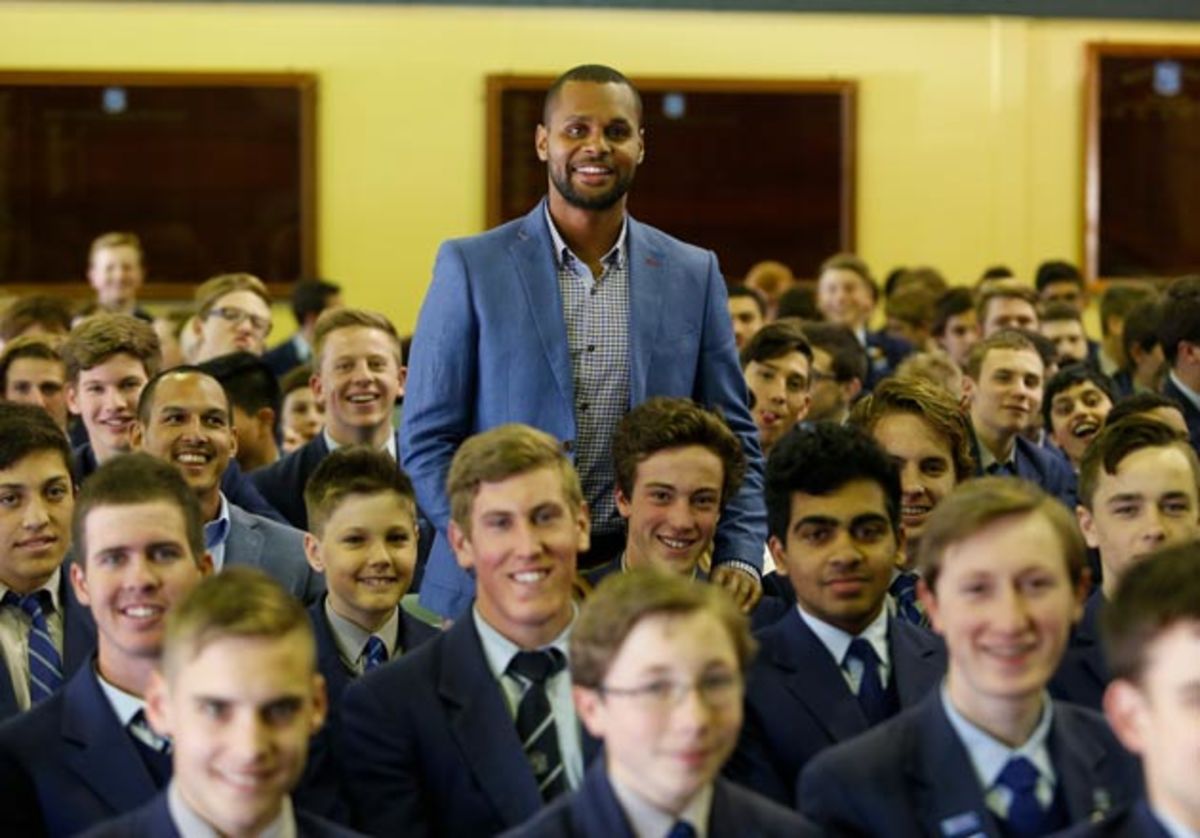
At the 2000 Olympics, in Sydney, Patty Mills, then 12, watched TV mesmerized as Aboriginal sprinter Cathy Freeman lit the cauldron and then, during her victory lap after winning the 400 meters, carried both the Southern Cross and the Aboriginal flag. Many members of the foreign press described those moments as evidence of a new Australia, at peace with its past. In fact, in a poll of 718 Australians taken by The Daily Telegraph of Sydney, 71% disapproved of Freeman’s selection to light the cauldron. An outpouring of letters in dailies around the country during the Olympic fortnight not only criticized her role in the opening ceremony and her waving of the Aboriginal flag but also ripped her personally.
Only two years ago, again at Collingwood, a 13-year-old girl in the stands called Sydney Swans star Adam Goodes an “ape.” (The Collingwood club president apologized afterward, claiming that the girl didn’t realize that her comment was a slur.) Mills considers Goodes’s measured response a model for any indigenous athlete. “The press conference he held was absolutely perfect,” Mills says. “He used the incident as an example of how racism is still out there and everyone can learn from what happened. Now he’s the face of anti-racism, and he was named Australian of the Year.” Yet five days later, the same Collingwood executive made a crack on a radio show linking Goodes to a production of King Kong.
Until a nationwide referendum granted full citizenship rights to indigenous Australians in 1967, they were considered “like a plant or an animal,” says James Rush, a Melbourne-based filmmaker whose documentary about Mills, For My People, will be released later this year. “White Australians don’t want to talk about it, and it’s so recent, so raw, that it’s a sensitive topic. And then there are those who don’t even know the Torres Strait Islands exist. So he’s not only educating people around the world, he’s educating Australians. Patty’s a bridge builder. And as an NBA star, he’s got the cool factor. Crazy as it sounds, there aren’t many people who are proud to be indigenous. And Patty, he’s putting it on the world stage. He knows the impact of what he’s doing, though I don’t think he really understood it until he came back for the Trophy Tour.”
No other NBA champion had ever taken the Larry O’Brien Trophy on the road, Stanley Cup–style. But in the blush of the Spurs’ title, forward Matt Bonner asked the front office if he could take it home to New Hampshire for his annual music festival. Other players got wind of Bonner’s request, and soon the Spurs had arranged an itinerary with five Stateside stops, plus visits to Argentina, Australia, Brazil, Canada, Italy and France. The Aussie leg hit six cities in seven days, for a roundelay of interviews and meet-and-greets featuring Baynes and Mills, who was undeterred by the sling for his recovering shoulder. Lazza is Aussie slang for Larry, so Mills dubbed their two-foot-high, gold-plated companion Bala Lazza.
A thousand fans turned out in Canberra, where the line for autographs and photos snaked around a city block. In Sydney, Bala Lazza posed by the Harbour Bridge and the Opera House. And when the Trophy Tour reached the Thursday Island ferry wharf, the Spurs’ delegation was met by Mills family members, elders and a dance team from Murray Island led by one of Patty’s aunts and Eddie’s descendants, Betty Mabo. After a procession to ANZAC Park, Mills and Baynes were each given a dhari, acknowledgment of their status as latter-day warriors.
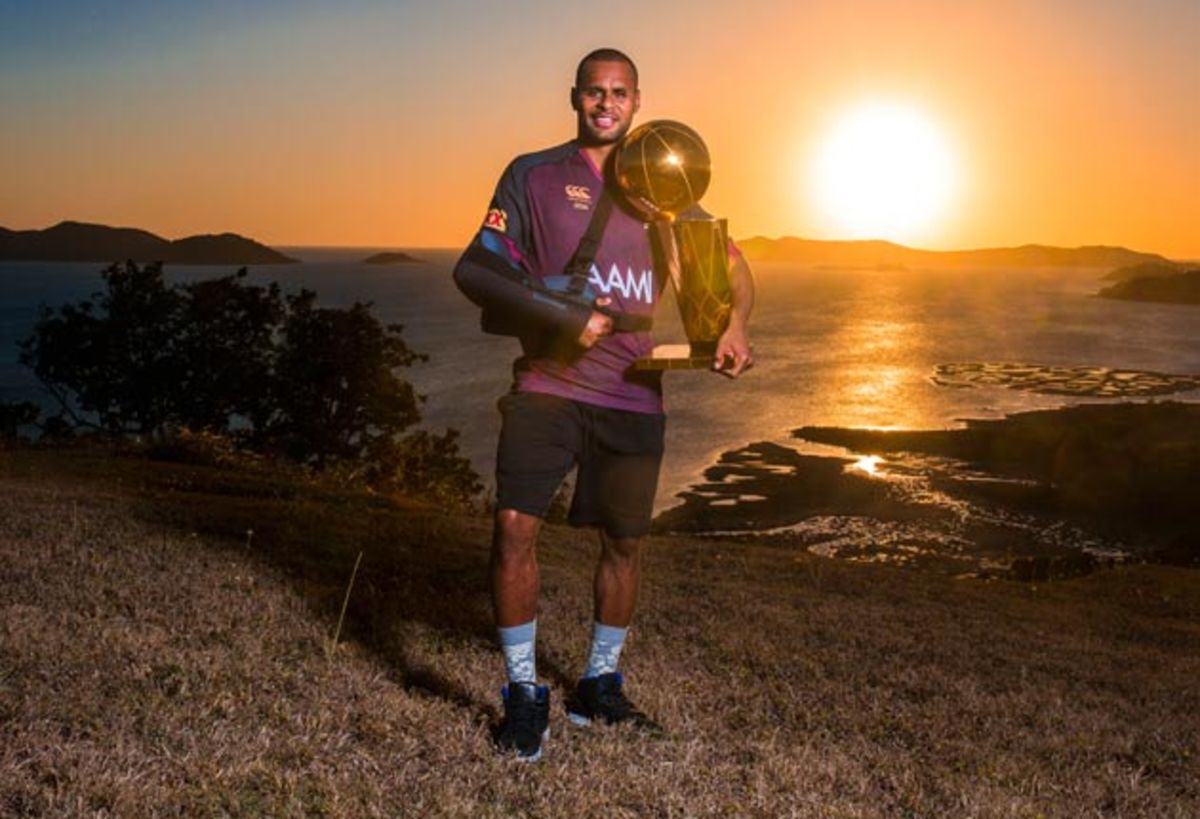
“We have a saying in the Torres Strait,” says Pedro Stephen, mayor of the Torres Shire Council. “We ‘throw words.’ So when you speak into the air, you’re communicating with your ancestors.” When the chairman of the Torres Strait Regional Authority, Joseph Elu, likened Patty Mills to Eddie Mabo, the original presumably took note.
As dusk fell and the visitors and their hosts feasted on fried turtle and a sea mammal called dugong, the Murray Island troupe performed a traditional dance around Bala Lazza, with Patty and members of his family eventually joining in. “I wanted to jump in from the get-go,” Patty says, “but I was in the sling, and if there was video, I didn’t know what Pop would say. Then I thought, You know, I’ll deal with Pop back in San Antonio.”
Before leaving the island, Mills had a few more rounds to make. He sat Lazza for a photo in his grand-father’s favorite chair on the balcony of Sam Mills’s old home, from which Patty’s dato could see the grave of his wife, Salome, who died in 1993, and north all the way to Hammond Island. In Green Hill Cemetery he put Lazza between his grandparents’ tombstones. And he found the site of a beloved family photograph in which the 10-year-old Patty shoots at that basketball goal his grandfather put up. There, at the spot of that long-since removed hoop, he posed the Larry O’Brien Trophy for one last snapshot, an image to connect his past with his present.
Of that—and of much that Bala Lazza and Bala Pat did back in the Land of the Fair Go—Pop would surely approve.
